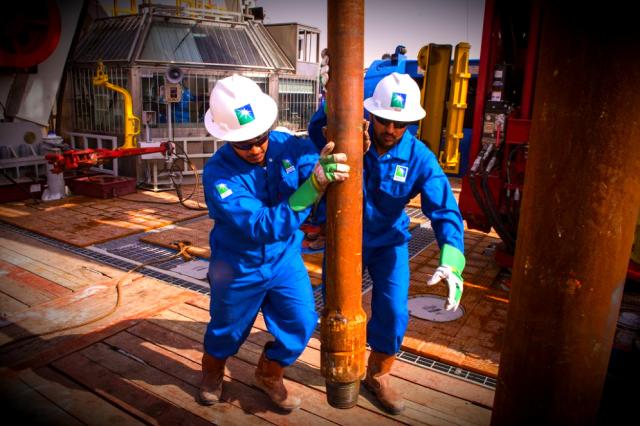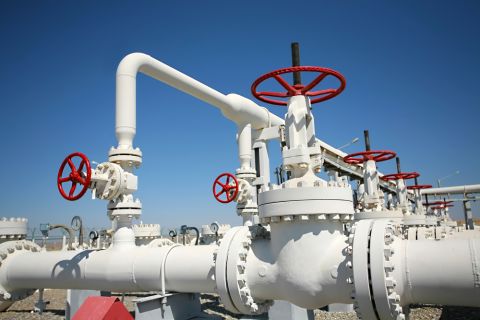
On an onshore rig added to Saudi Aramco’s owned rig program. (Source: Saudi Aramco)
Barely a few days after OPEC+ announced historic supply cuts, one thing was clear—it wasn’t enough to offset destruction to oil demand. Though, the question remains whether members of the alliance will follow through on the promised cuts.
“I don’t think we should necessarily believe that the announced cuts over the next two years will be delivered,” said Bill Farren-Price, director of RS Energy Group, speaking at a webinar jointly hosted by Enverus and RS Energy Group. “Historically, when prices rise, OPEC+ compliance weakens.”
Out of the 9.7 MMbbl/d that OPEC+ agreed to cut starting May 1, Farren-Price expects compliance to be between 6-7 MMbbl/d.
He went on to highlight the “unusually short time” it took for OPEC and other producers including Russia, which had been in a price war with Saudi Arabia, to strike a record deal that removes almost 10% of global supply.
“It was extraordinary to see cuts of that size pulled together by parties who were in a price war at such short notice,” he said, adding that political pressure by the White House might have helped.
In addition, the alliance agreed to restrain production for two years, which he noted is rare.
“It’s worth emphasizing that because it means [OPEC+ countries] are trying to give a clear message that they are planning to underpin the prices and trying to help rebalance the market through supply management,” he said.
Middle East
Although strong compliance is expected from top oil exporter and de facto OPEC leader Saudi Arabia, backed by its Gulf Cooperation Council counterparts, there are doubts regarding supply cuts from other important and large producers including Iraq, which holds a patchy record, according to Farren-Price.
Compliance from Iraq is difficult due to the country’s constant political crisis because of which the country has only managed to deliver cuts from state-controlled oil fields in the past, he said.
The recently pledged cuts of over 1 MMbbl/d will require the country to ratchet back production from the major joint ventures of Iraqi oil companies with international oil companies (IOCs). According to the contracts, national oil companies will need to financially compensate IOCs, making it more difficult for Iraq to cut oil supply.
However, given the unprecedented times, Farren-price anticipates the countries could begin making some, if not total progress in May—the first official month of the announced cuts.
Regardless of past records, most countries will be forced to scale back oil production due to global shortage of storage space as the oil sector is set to see demand destruction continue, he said.
Some countries like Kuwait have begun implementing early cuts.
The fourth-biggest member of OPEC, Kuwait “felt responsibility to respond to market conditions” and acted on its own, Oil Minister Khaled Al-Fadhel said, according to the official Kuwait News Agency. He didn’t specify if the country has scaled back production by the full amount it pledged to cut, or only part of it.
Saudi Arabia is also considering a proposal to begin cutting production immediately, if it aligns with the country’s legal obligations and agreed upon deliveries, according to The Journal.
Russia
Full compliance from Russia is not expected initially since the country has a tendency to comply toward the end of the cuts agreement period, Farren-Price said.
Russia has made minimal production cuts in the past, scaling back production by 200,000 bbl/d at most. In contrast, the current supply cuts of 2.5 MMbbl/d pledged by Russia are “really significant,” he said.
Another matter of concern is that Russian oil producers have maintained flat output in April ahead of OPEC+ cuts.
The country’s crude and condensate production averaged 11.28 MMbbl/d from April 1-23—a week before the agreed cuts are expected to begin. The figures, which were reported by Bloomberg citing data from the Russian energy ministry, show the country may not be able to reach its target for production cuts of 2.5 MMbbl/d since it takes time to slow down production at complex fields in cold weather and complex geology.
Recommended Reading
For Sale? Trans Mountain Pipeline Tentatively on the Market
2024-04-22 - Politics and tariffs may delay ownership transfer of the Trans Mountain Pipeline, which the Canadian government spent CA$34 billion to build.
Energy Transfer Announces Cash Distribution on Series I Units
2024-04-22 - Energy Transfer’s distribution will be payable May 15 to Series I unitholders of record by May 1.
Balticconnector Gas Pipeline Back in Operation After Damage
2024-04-22 - The Balticconnector subsea gas link between Estonia and Finland was severely damaged in October, hurting energy security and raising alarm bells in the wider region.
Wayangankar: Golden Era for US Natural Gas Storage – Version 2.0
2024-04-19 - While the current resurgence in gas storage is reminiscent of the 2000s —an era that saw ~400 Bcf of storage capacity additions — the market drivers providing the tailwinds today are drastically different from that cycle.
Ozark Gas Transmission’s Pipeline Supply Access Project in Service
2024-04-18 - Black Bear Transmission’s subsidiary Ozark Gas Transmission placed its supply access project in service on April 8, providing increased gas supply reliability for Ozark shippers.




